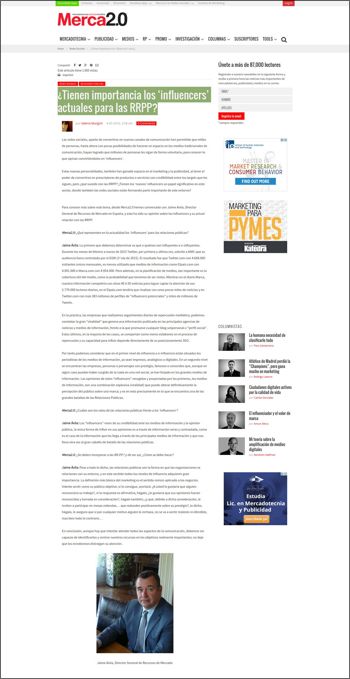Social networks, apart from becoming new channels of communication, have allowed thousands of people, who until now had little chance of gaining a space in the traditional media, to have millions of people follow them voluntarily, to find out what they think, turning them into ‘influencers’.
These new personalities have also gained space in marketing and advertising, as they have the power to become prescribers of products or services with credibility among the targets that follow them, but what about public relations? Do the ‘new’ influencers have a significant role in this sector, where social networks are also forming an important part of this context?
 To find out more about this topic, Merca2.0 spoke to Jaime Ávila, General Director of Market Resources in Spain, and this is his opinion on influencers and their current relationship with PR.
To find out more about this topic, Merca2.0 spoke to Jaime Ávila, General Director of Market Resources in Spain, and this is his opinion on influencers and their current relationship with PR.
Merca2.0: What do influencers currently represent for public relations?
Jaime Ávila: The first thing we must determine is what or who are influencers or e-influencers. During the months of February to March 2015, Twitter, for the first and last time, asked AIMC for its audience to be monitored by the EGM (1st wave of 2015). The result was that Twitter.com, with 4,668,000 unique monthly visitors, is less used than news media such as Elpais.com with 4,991,000 or Marca.com with 4,954,000. However, in media planning, the useful coverage of the medium is just as important as the probability of being seen. While in the daily Marca, our information would compete with 40 or 50 other news items to capture the attention of its 2,779,000 daily readers, in Elpais.com it would have to compete with a few thousand news items and in Twitter.com with more than 383 million profiles of “potential influencers” and billions of Tweets.
In practice, those of us who monitor the media impact on a daily basis can confirm the great “virality” generated by information published in the main news agencies and information media, compared to that promoted by any one-person blog or “social profile”. The latter, in most cases, behave as mere links in the impact process and their capacity to influence depends directly on their SEO positioning.
We can therefore consider that the first level of influence or e-influence includes journalists in the media, whether print, analogue or digital. On the second level are companies, people or personalities with prestige, famous or well-known people who, although in some cases they may have emerged from nowhere on a social network, have been forged in the mainstream media. The opinions of these “influencers”, gathered and projected by the media, are an explosive combination (virality) that can definitively alter the public’s perception of a brand; and this is precisely where one of the great battles of Public Relations lies.
Merca2.0: What are the challenges for public relations in the face of influencers?
Jaime Ávila: Influencers live off their credibility in the eyes of the media and public opinion. The only way to influence their opinions is through truthful and contrasted information, as is the case with the information that reaches them through the mainstream media, which brings us back to the great workhorse of public relations.
Merca2.0: Should they be incorporated into PR, and if so, how?
Jaime Ávila: Despite all that has been said, public relations is the way in which organisations relate to their environment, and in this sense all levels of influence are of great importance. The most basic definition of marketing is common sense applied to business. Try to feel like your target audience, if you get it right, you’ll get it right. Would you like someone to recognise your work, if yes, do it; would you like your opinions to be recognised and taken into consideration, do it too; and what if you would like your opinions to be recognised and taken into consideration? Do it too; and that, because of this consideration, you are invited to participate in round tables… that will have a positive impact on your prestige, do it, I assure you that if for any reason someone rejects you, you will not feel annoyed or offended, on the contrary, you will feel just the opposite…
In conclusion, while trying to address all aspects of communication, we must be able to identify them and focus our resources on the really important objectives; don’t let snobbery distract your attention.
Interview with Jaime Ávila Rodríguez de Mier
General Director of Recursos de Mercado
Published on 4 May 2016 by Valeria Murgich in:




